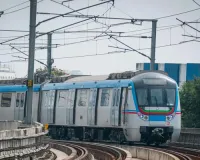Prakasam Barrage facing unprecedented flood threat

• Flood levels approaching barrage’s design parameters, leaving little margin for safety • Water level recorded at 21.52 meters against designed MFL of +22.13 meters • Rising water…
• Flood levels approaching barrage’s design parameters, leaving little margin for safety
• Water level recorded at 21.52 meters against designed MFL of +22.13 meters
• Rising water levels placing enormous stress on the barrage
Varaprasadarao K
The Prakasam Barrage is under an unprecedented threat as floodwaters have risen to levels not seen in the last century. Despite fully raising the barrage’s gates to release water, the situation remains extremely dangerous. The water level was recorded at 21.52 meters at 10 a.m. on Monday, dangerously close to the barrage’s designed Maximum Flood Level (MFL) of +22.13 meters. The discharge reached 11,39,351 cusecs, surpassing the record set during the 2009 flood. The flooding, aggravated by heavy rains over the past four days and additional inflows from the Budameru rivulet, has submerged large parts of Vijayawada city, forcing lakhs of residents to evacuate while many remain trapped in their homes. Downstream villages are also experiencing catastrophic flooding.
The Prakasam Barrage, designed to withstand an MFL of +22.13 meters (72.60 feet), is nearing its critical threshold. The barrage has previously endured significant floods, including the 2009 event with a discharge of 11,10,404 cusecs, which raised the water level to +20.97 meters (68.78 feet). However, the current discharge exceeds this previous record, pushing the structure closer to its design limits. Historical flood events have seen levels reach 10.60 lakh cusecs in 1903, with other significant floods recorded as around 9 lakh cuses in 1914, 1917, 1949, 1964, and 1998.
The rising water levels pose a serious threat to the barrage’s structure, gates, and abutments. Concerns have been raised about the maintenance and management of the barrage gates, adding to the anxiety surrounding the barrage’s current condition. Upstream areas are also at heightened risk due to backwater buildup, which can further elevate water levels and strain the barrage.
In 2009, the rise in upstream water level (afflux) was measured at 0.66 meters (2.16 feet), and any further increase could dangerously elevate pressure on the structure. The situation demands immediate attention and the consideration of redundancy measures for the future, such as auxiliary spillways or relief structures, to manage excessive flows and prevent potential structural failure.
With the current discharge alarmingly close to the barrage’s design parameters, there is little margin for safety. With Vijayawada and surrounding regions under severe threat, authorities must act swiftly to ensure the safety of residents and the integrity of the Prakasam Barrage.









